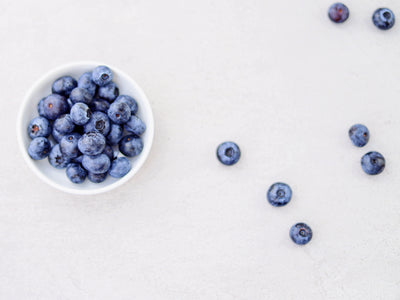How to Reduce Your Body’s Toxic Load: Part 1

Conscious Spaces Detox Special
In the New Year spirit of fresh starts and clean slates, we’re serving up a rejuvenating detox special: a series of features focused on what contributes to your toxic load, and – most importantly - practical, positive advice on ways you can work to dramatically reduce it, with almost immediate effect.
The hidden chemicals in everyday products
A new study (1) has found that humans are being exposed to 44 times more cancer-linked and infertility-associated chemicals than previously thought - far exceeding recommended ‘safe’ levels.
Published in a peer-reviewed scientific journal, the research focuses on bisphenol-A (BPA), a widely used, dangerous toxin present in plastic, canned goods and receipt paper, which is a known hormone-disruptor.
Pregnant women who are exposed to BPA are more likely (2) to have children with growth, behavior and fertility problems, as well as a higher cancer risk.
Bringing into sharp focus the toxins we’re inadvertently absorbing every day, the study comes as awareness and anxiety over the impact that man-made chemicals could be having on our health are growing.
What is a ‘toxic load’?
Whether from the food we eat, the things we drink, the air we breathe or the products that touch our skin, our bodies face a daily barrage of toxins. Making plastics malleable, pans nonstick, fabrics waterproof, shower gel fragrant, furniture fire-resistant and cleaning sprays antibacterial, a litany of industrial, artificial chemicals combine with impurities and pollutants like pesticides, hydrogenated fats, prescription drugs, mercury, and lead, meaning the mere experience of everyday existence is saturated with synthetic substances.
The accumulation of all these chemicals together inside your body creates what is known as your ‘toxic load’ or ‘toxic burden’.
Reassuringly, according to the Alliance for Natural Health International, (3) the human body is well adapted to dealing with toxins; excreting them mainly via urine, sweat and stools. However, the Alliance also cites growing evidence that modern exposure levels to industrial toxins, may “over-burden inbuilt detoxification and biotransformation systems”, meaning the body’s natural ability to eliminate toxins is compromised – resulting in “toxin overload”, and all of the health issues that go with it.
Chemical substances + serious health issues – a correlation?
Whilst it’s difficult for scientists to pinpoint a direct link, it seems more than coincidental that chronic illnesses, including asthma and allergies in children, have been on the rise (4) for the same period of time as the dominance of modern synthetic chemicals has been steadily increasing. And it’s not only chronic conditions that have been running rampant, either. From the early 1980s through the late 1990s, autism increased tenfold; (5) from the early 1970s through the mid-1990s, male birth defects doubled, and one form of leukemia was up 62 percent. Compared with 1998, there are now (6) 1, 300 more cases of childhood cancer.
Dr Denis Henshaw, Professor of Human Radiation Effects at Bristol University, (7) told The Telegraph, (8) “when you look at cancers such as childhood leukaemia there is no doubt that environmental factors are playing a big role.” Henshaw went on to explain, “Many items on the list of environmental causes are now known to be carcinogenic, such as air pollution and pesticides and solvents. There has been good research to suggest a mother's diet can damage DNA in cord blood. Burnt barbecues, the electric fields of power lines, the electricity supply in your home. It’s all of these things coming together.”
What is clear, is that whilst many chemicals have positive uses, we all need to be more aware of exactly what’s in the things we put in, on, and around our bodies, so that we can start to make informed decisions that increase our wellbeing.
We can’t control everything or avoid chemicals altogether, but we can radically reduce our exposure to some of the worst offenders through simple lifestyle changes.
So, where should you begin?
Tactic number one: GO ORGANIC
Choosing organic produce is one of the easiest ways to reduce your exposure to toxic chemicals. Besides promoting greater sustainability and higher animal welfare, (9) organic means no industrial herbicides or synthetic fertilizers, and significantly lower levels of pesticides (with most organic pest control being naturally derived and harmless to humans).
The positive health impact of an organic diet can be almost immediate, too. One 2019 study (10) found that after only six days of eating organic food, subjects had on average 60% less synthetic pesticides in their urine. The same study also showed that an organic diet reduced levels of chlorpyrifos, a neurotoxic pesticide that can harm the brain of a developing foetus, as well as malathion, a pesticide classified as a ‘probable’ human carcinogen.
And more good news - organic meat is free from (11) the antibiotics and drugs so commonly found in meat produced via intensive farming systems.
Under strict organic standards laid down in European law, unhealthy hydrogenated fats and artificial preservatives and food colours are also banned, with all organic producers facing rigorous inspections to ensure they’re up to scratch.
Pesticides: “intrinsically toxic”
In contrast, non-organic crops are routinely sprayed with a noxious cocktail (12) of chemical herbicides, fungicides, fertilizers and pesticides; labelled ‘intrinsically toxic’ (13) by the World Health Organisation (WHO). In the UK alone, 300 pesticides are known to be used (14) in modern non-organic farming, often making their way into the food on our plates.
As the Center for Disease Control and Prevention (CDC) explains, (15) “a wide range of health effects, acute and chronic, are associated with exposures to some pesticides, including cancer, nervous system impacts, skin and eye irritation, and endocrine disorders.” The CDC goes on to say that “the health risks from pesticide exposure depend on the toxicity of the pesticides, the amount a person is exposed to, and the duration and the route of exposure,”, saying evidence indicates children are at higher risk.
In the US, a recent report (16) by the Environmental Working Group (EWG) revealed that 70% of fresh produce sold in America contains pesticide residues – even after it has been thoroughly washed and peeled. More than 92% of conventionally farmed kale tested contained two or more pesticide residues, and a single sample could contain up to 18 different pesticides. Datchal, or DCPA – classified as a ‘possible human carcinogen’ by the Environmental Protection Agency (EPA) - was detected in nearly 60% of US kale samples. It’s not just the initial eating of these pesticide residues that’s the problem either, as levels can build up in our tissues and fat cells, increasing our body’s overall cumulative toxic burden.
The health benefits of a diet low in pesticide residues have repeatedly been proven by scientists. One recent French study (17) found that of the 68, 946 adults analysed, those eating an organic diet had “a significant reduction in the risk of cancer”, warranting further research of underlying factors “to implement adapted and targeted public health measures for cancer prevention.”.
In 2018, a separate Harvard study (18) found that for women undergoing infertility treatment, those who ate more high-pesticide fruits and vegetables were less likely to have a live birth, whilst “low-pesticide residue fruit and vegetable intake was not associated with this outcome.”
QUICK PESTICIDE GUIDE
Which foods are the worst offenders when it comes to pesticides? *
The foods that contain the most pesticides, AKA ‘The Dirty Dozen’:
- Strawberries
- Spinach
- Kale
- Nectarines
- Apples
- Grapes
- Peaches
- Cherries
- Pears
- Tomatoes
- Celery
- Potatoes
And the fewest, AKA ‘The Clean Fifteen’:
- Avocados
- Sweet corn**
- Pineapples
- Frozen sweet peas
- Onions
- Papayas
- Eggplants
- Asparagus
- Kiwis
- Cabbages
- Cauliflower
- Cantaloupes
- Broccoli
- Mushrooms
- Honeydew melons
*Source: The Environmental Working Group's 2019 assessment of USDA data.
** it’s good to be aware that, although sweetcorn might have made it into the ‘Clean 15’, genetically modified non-organic sweetcorn is on the rise. (19) Genetically Modified Organisms (also known as GMOs) pose their own significant health issues - something we’ll be covering in future articles.
If you’d like to find out more about what pesticides you and your family are being exposed to, the Pesticide Action Network UK has surveyed and ranked (20) the top ten UK supermarkets; providing a helpful guide to how each supermarket is performing on eight key topics related to pesticides, from the use of hazardous substances to the number of organic products on offer.
Where to find the best organic produce
Conscious Spaces Founder Tara recommends staying as close to home as possible when trying to incorporate more organic foods into your diet: “look out for local organic producers or farmers’ markets in your area, as these will almost always offer more cost effective, seasonal and - best of all - locally produced options than those you’ll find on supermarket shelves. Get to know your local organic market stall holders or farm shop staff, as that way you can really trust in what you’re buying and feel confident you’re getting chemical-free produce that hasn’t travelled thousands of miles to get here, whilst supporting local businesses at the same time.”
Organic produce is also becoming more readily available through farm-to-home delivery services, with veg box schemes proving especially popular. Delivered direct to your door and hand-selected for you, it makes getting your organic, seasonal five-a-day fix simple. We love Riverford, Eversfield Organic and Abel & Cole.
Or why not try growing your own? “Even just starting with something small like herbs, growing your own is always fun. It’s just really satisfying knowing you have contributed directly to your health,” says Tara. “Coriander would make a perfect starter herb, as it’s brilliant at removing heavy metals and other toxins from the body - and of course, delicious too!”
UP NEXT: Our detox special continues with the second instalment of our series on how to reduce your body’s toxic load
References
(1) https://www.thelancet.com/journals/landia/article/PIIS2213-8587(19)30381-X/fulltext
(2) https://www.thelancet.com/journals/landia/article/PIIS2213-8587(19)30381-X/fulltext
(3) https://www.anhinternational.org/resources/documents/anh-intl-blueprint-for-health-system-sustainability/
(4) https://www.ncbi.nlm.nih.gov/pubmed/20059582
(5) https://www.nationalgeographic.com/science/health-and-human-body/human-body/chemicals-within-us/
(6) https://www.telegraph.co.uk/science/2016/09/03/modern-life-is-killing-our-children-cancer-rate-in-young-people/
(7) http://www.bris.ac.uk/
(8) https://www.telegraph.co.uk/science/2016/09/03/modern-life-is-killing-our-children-cancer-rate-in-young-people/
(9) https://www.soilassociation.org/organic-living/why-organic/
(10) https://www.sciencedirect.com/science/article/pii/S0013935119300246
(11) https://www.soilassociation.org/organic-living/why-organic/
(12) https://hippocratesinst.org/why-buy-organic-food
(13) https://www.who.int/news-room/fact-sheets/detail/pesticide-residues-in-food
(14) https://www.soilassociation.org/organic-living/why-organic/
(15) https://ephtracking.cdc.gov/showPesticidesHealth
(16) https://www.ewg.org/foodnews/summary.php
(17) https://jamanetwork.com/journals/jamainternalmedicine/article-abstract/2707948
(18) https://jamanetwork.com/journals/jamainternalmedicine/article-abstract/2659557
(19) https://responsibletechnology.org/sweet-corn-non-gmo-right-read
(20) https://www.pan-uk.org/supermarkets/











































